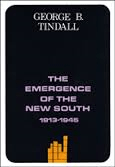 [NOTE: The previous post in this series looked at an early step on the road to my course on the modern Civil Rights Movement: a one-term elective, “The South and the Sectional Image,” which we offered at Atlanta’s Finest Prep School (AFPS) for a few years in the late 1970s. This post looks at another early influence, the introduction to a panel discussion, “Is It True What They Say About Dixie? Myth and Reality in Recent Southern History.” If you’ve read the previous post, you will recognize the similarity in approach to this panel.
[NOTE: The previous post in this series looked at an early step on the road to my course on the modern Civil Rights Movement: a one-term elective, “The South and the Sectional Image,” which we offered at Atlanta’s Finest Prep School (AFPS) for a few years in the late 1970s. This post looks at another early influence, the introduction to a panel discussion, “Is It True What They Say About Dixie? Myth and Reality in Recent Southern History.” If you’ve read the previous post, you will recognize the similarity in approach to this panel.
I organized the discussion for a meeting of a regional independent schools organization in Atlanta (Spring 1978), around the time the article in the previous post was originally published. The panelists included a Morehouse College history professor; a veteran Southern bureau chief for a major national news magazine; and the author of a new, well-received biography of eccentric racist Georgia politico Eugene Talmadge.]
* * * * *
Jimmy Carter first rose to prominence in 1970 as one of a group of young, racially moderate Southern governors whom the press dubbed spokesmen for a “New South.” What exactly was this “New South”? To try to answer this question, let’s consult the influential multi-volume History of the South series from Louisiana State University Press.
In Volume IX, C. Vann Woodward takes nearly five hundred pages to discuss the “origins” of the New South, between 1877 and 1913. George B. Tindall requires over seven hundred pages in Volume X to analyze the “emergence” of the New South, which he places between 1913 and 1945.
So, after twelve hundred pages treating in detail almost seventy years of history, the New South finally “emerges,” but we are still a quarter of a century away from the election of Jimmy Carter and the other so-called “New South Governors.” That is a mighty long gestation period for the birth of a “New South,” even if Southerners are, so some historians tell us, congenitally slow and lazy!
[Historiographical Note, 2015: It wasn’t until 1995, nearly two decades after the panel discussion, that Numan V. Bartley, in Volume XI, The New South, 1945-1980, used over four hundred and fifty more pages to carry the story to 1980; Carter and the other moderate “New South Governors” finally show up, in chapter eleven (of twelve).
 So, to review, we now have almost seventeen hundred pages, in three hefty volumes, to cover the story of the “New South” between the end of Reconstruction and the presidency of former “New South Governor” Jimmy Carter! Got that? Now back to 1978. . . .]
So, to review, we now have almost seventeen hundred pages, in three hefty volumes, to cover the story of the “New South” between the end of Reconstruction and the presidency of former “New South Governor” Jimmy Carter! Got that? Now back to 1978. . . .]
Nevertheless, the New South, whatever it is, goes on, and so does the search for it. Most of us treat the recent history of this region in the context of the American History survey course, which means we rely heavily on generalizations. Yet, as I tried to show in my homily on the “New South Governors,” generalizing about Southern history can be a tricky business.
In fact, one student of the region, Pat Watters, has compared trying to understand the South to the search for solid ground in the Okefenokee Swamp:
An Indian word meaning “Land of the Trembling Earth,” [Okefenokee] stands for the islands of floating vegetation that comprise much of the swamp; these islands are called by swamp people “houses,” and some are large enough to support trees with roots trailing in the water below. To step from a boat onto one of the “houses” is a dismaying experience; the land does literally shake and bob underfoot. If you don’t know how to walk this land, your feet quickly sink into the muck and the cold water below. The swamp people walk it with quick jerking steps, barely letting a foot touch down before lifting it, moving in a hopping lope. So it is, with contemplation of the South. If one jumps to what seems an obvious conclusion, likely as not the solid-seeming fact that ought to be supporting it will give way underneath. Better it is to hop from one point of fact or judgment to another with the tentativeness of the swamp people, distrusting the obvious but aware, always, that somewhere back through the jungle trails and across the trembling earth, solid truth will be found. One of the real islands in the Okefenokee Swamp once supported a good-sized logging town, with a main street and even a picture show. (Watters, The South and the Nation, pp.129-130)
Times change, as do historical interpretations, and this means that generalizations change also. It is to generalizations about the recent South that we shall direct our attention today. What can we say with some assurance to our students about the South’s continuing distinctiveness, or lack thereof; about the nature of modern Southern politics; about changes wrought in recent years on the region’s economic, social, and cultural life?
Our three distinguished panelists will try to aid us in this quest for the modern South. Welcome to the Okefenokee Swamp, gentlemen!
* * * * * *
For those interested in reading more of my reflections on history, here are links to my books on the subject:
 Rancorous Enmities and Blind Partialities: Parties and Factions in Georgia, 1807-1845 (University Press of America, 2015)
Rancorous Enmities and Blind Partialities: Parties and Factions in Georgia, 1807-1845 (University Press of America, 2015)
In Pursuit of Dead Georgians: One Historian’s Excursions into the History of His Adopted State (iUniverse, 2015)






